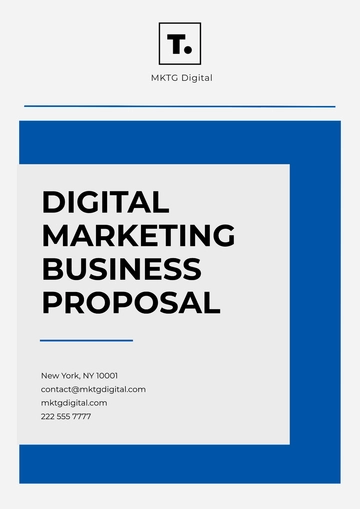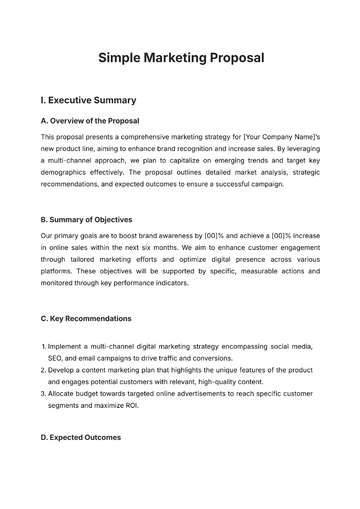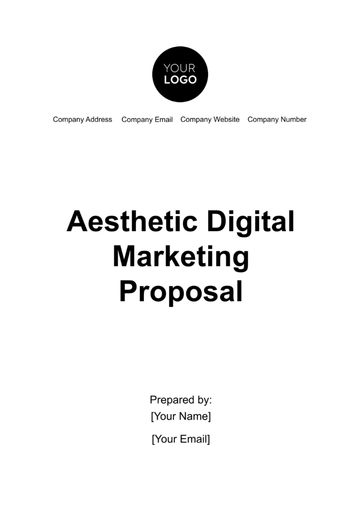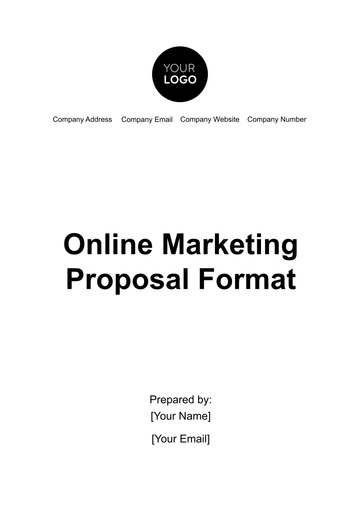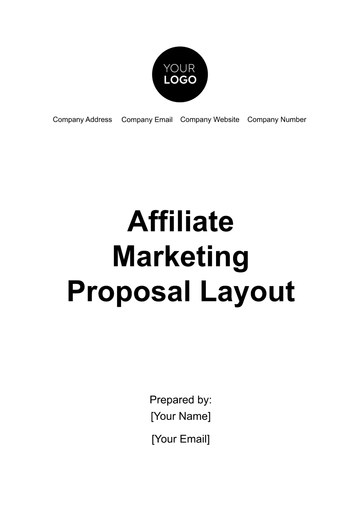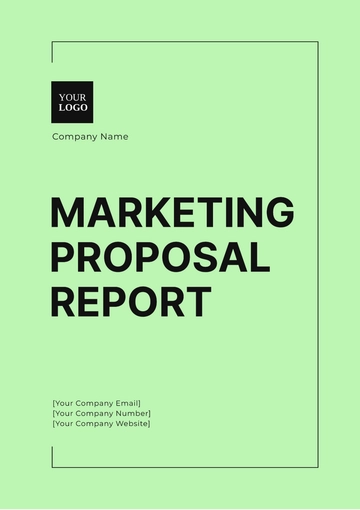Free Aesthetic Movie Theater Marketing Proposal

I. Executive Summary
A. Introduction
Purpose of the Proposal
The primary purpose of this marketing proposal is to present a detailed and strategic plan to enhance the visibility and boost the attendance of the aesthetic movie theater operated by [Your Company Name]. This proposal outlines a multifaceted approach to marketing, designed to attract a larger audience, increase ticket sales, and elevate our brand's presence within the community. By implementing this strategy, we aim to solidify our position as the premier destination for an exceptional movie-watching experience.Overview of [Your Company Name]
[Your Company Name] stands at the forefront of the entertainment industry, renowned for its commitment to delivering unique and immersive cinematic experiences. Our theaters are equipped with cutting-edge projection technologies, luxurious seating arrangements, and a diverse film selection that caters to a broad audience, from blockbuster enthusiasts to independent film aficionados. Our dedication to providing a superior movie experience sets us apart from conventional theaters, making us a preferred choice for moviegoers seeking more than just a film screening.
B. Objectives
Increase Audience Engagement
We are targeting a 30% increase in audience engagement over the next 12 months. This will be achieved through a series of targeted marketing campaigns, interactive promotions, and enhanced customer interaction both online and in-person. Our approach will involve creating engaging content, fostering community interaction, and utilizing feedback to continually improve our offerings.Boost Ticket Sales
Our goal is to increase ticket sales by 25% within the next year. This objective will be pursued through a combination of promotional offers, dynamic pricing strategies, and strategic partnerships. By attracting new customers and encouraging repeat visits, we aim to achieve substantial growth in our ticket sales figures.Enhance Brand Awareness
We seek to enhance brand awareness by positioning [Your Company Name] as the go-to destination for an unparalleled movie theater experience. Our target is a 20% increase in brand recognition within the local community. To achieve this, we will employ a comprehensive marketing strategy that emphasizes our unique selling points and engages with our audience through multiple channels.
II. Market Analysis
A. Industry Overview
Current Market Trends
The movie theater industry is witnessing a resurgence in popularity as audiences seek shared experiences and high-quality entertainment options. Post-pandemic, there has been a notable increase in demand for immersive viewing experiences, including advanced formats such as IMAX, 3D, and Dolby Atmos. Additionally, there is a growing interest in exclusive screenings, film festivals, and themed events that offer a unique twist on traditional movie-going.Market Growth Potential
According to industry forecasts, the movie theater sector is expected to grow at a compound annual growth rate (CAGR) of 7% over the next five years. This growth is driven by several factors, including technological advancements in film projection, an increase in consumer spending on leisure activities, and a rising appetite for premium entertainment experiences. The market's expansion presents a significant opportunity for theaters to capitalize on evolving consumer preferences and enhance their offerings.
B. Target Audience
Demographics
Our target audience primarily consists of individuals aged 18-45, encompassing a diverse range of moviegoers from students and young professionals to families and empty nesters. This demographic is characterized by a high level of disposable income, a strong interest in entertainment, and a willingness to invest in premium experiences. They are likely to be urban dwellers with access to multiple entertainment options, making it essential to differentiate our theater through unique value propositions.Psychographics
The psychographic profile of our target audience includes a deep appreciation for cinematic artistry, a desire for social experiences, and an affinity for high-quality entertainment. This audience values exclusivity and seeks out opportunities for unique and memorable experiences. They are also highly active on social media platforms, where they share their opinions and recommendations, making it crucial for our marketing efforts to resonate with their values and preferences.
C. Competitor Analysis
Direct Competitors
Our direct competitors include other local movie theaters that offer similar services. Notable competitors in our area include XYZ Cinemas, known for its standard film screenings and occasional special events; ABC Theaters, which provides a range of viewing options but lacks the aesthetic focus; and DEF Movieplex, which offers a high volume of showings but does not prioritize the immersive experience that [Your Company Name] provides.Indirect Competitors
Indirect competition comes from streaming services such as Netflix, Amazon Prime, and Disney+, which offer the convenience of watching films at home. While these services provide a wide selection of content and personalized recommendations, they lack the communal and immersive experience of a movie theater. Our challenge is to highlight the unique benefits of attending a physical theater, such as superior sound and visual quality, social interaction, and the excitement of new releases.
III. Marketing Strategy
A. Branding and Positioning
Unique Selling Proposition (USP)
Our Unique Selling Proposition (USP) lies in the distinctive aesthetic ambiance of our theaters. We offer a cinematic experience that combines luxurious seating, advanced projection technologies, and a carefully curated selection of films. This creates a compelling value proposition for moviegoers who seek an exceptional and memorable viewing experience. Our USP emphasizes quality, comfort, and exclusivity, setting us apart from more conventional movie theaters.Brand Positioning
We position [Your Company Name] as the ultimate destination for movie lovers seeking a superior and immersive theater experience. Our brand is synonymous with quality, innovation, and customer satisfaction. By focusing on our unique aesthetic features and personalized service, we aim to establish ourselves as the preferred choice for those who value a high-end movie-going experience. This positioning will be reinforced through targeted marketing efforts and strategic brand messaging.
B. Marketing Channels
Digital Marketing
Social Media Campaigns
Social media platforms, including Facebook, Instagram, and Twitter, will be utilized to engage with our audience through regular updates, interactive posts, and targeted advertisements. We will create visually appealing content that highlights our theater's unique features, upcoming events, and special promotions. By fostering a strong online presence and encouraging user-generated content, we aim to increase our social media following by 50% within six months. Our campaigns will also include interactive elements such as polls, contests, and behind-the-scenes glimpses to boost engagement and build a community around our brand.Email Marketing
Our email marketing strategy will involve sending a monthly newsletter to our subscribers, featuring information about upcoming releases, exclusive offers, and special events. The newsletter will also include behind-the-scenes content, interviews with filmmakers, and movie reviews to keep our audience engaged and informed. We aim to achieve an open rate of 25% and a click-through rate of 10%, leveraging personalized subject lines and compelling content to drive engagement and conversions.Search Engine Optimization (SEO)
To enhance our online visibility, we will implement a comprehensive SEO strategy that includes optimizing our website content, utilizing relevant keywords, and improving our site’s technical performance. Our objective is to increase organic traffic by 40% within a year. This will involve regular updates to our website’s content, the creation of high-quality blog posts related to film and cinema, and the acquisition of backlinks from reputable sources. By improving our search engine rankings, we aim to attract more visitors and drive higher engagement with our brand.
Traditional Marketing
Print Advertising
Print advertising will be used to reach a broader audience through local newspapers, magazines, and billboards. Ads will focus on highlighting special events, new movie releases, and unique features of our theater. By placing advertisements in high-traffic areas and popular publications, we aim to capture the attention of potential customers who may not be reached through digital channels alone. This traditional approach will complement our digital efforts and ensure a comprehensive marketing strategy.Radio and TV Spots
Short advertisements on local radio and TV stations will promote our theater’s unique offerings and upcoming events. These spots will be strategically scheduled during peak listening and viewing hours to maximize reach and impact. Our radio and TV ads will feature engaging content and call-to-action messages to encourage listeners and viewers to visit our theater. By leveraging these traditional media channels, we aim to build brand awareness and drive traffic to our location.
C. Promotional Activities
Special Events and Screenings
We will organize a variety of special events and screenings to attract movie enthusiasts and create buzz around our theater. These events will include film premieres, director Q&A sessions, themed movie nights, and exclusive screenings of highly anticipated films. By offering unique and memorable experiences, we aim to draw in new customers and foster a loyal community of moviegoers. Each event will be carefully planned and promoted to maximize attendance and generate positive word-of-mouth.Loyalty Programs
Our loyalty program will reward frequent visitors with points that can be redeemed for free tickets, concessions, and exclusive merchandise. The program will include various tiers of membership, each offering different benefits and rewards. By incentivizing repeat visits and encouraging customer loyalty, we aim to increase customer retention and drive sustained revenue growth. The program will be promoted through our website, social media channels, and email marketing campaigns to maximize participation and engagement.Partnerships and Collaborations
We will seek partnerships with local businesses, schools, and community organizations to promote our theater and offer joint promotions. These collaborations will include cross-promotional activities, special discounts for partner organizations, and community events. By working with local partners, we aim to expand our reach, build strong community ties, and attract new audiences. These partnerships will also provide opportunities for co-branded marketing efforts and shared promotional activities.
IV. Budget and Financial Projections
A. Budget Allocation
Digital Marketing
Social Media Campaigns: $50,000
This budget will cover the costs of creating high-quality content, running targeted ads, and utilizing social media management tools. It includes expenses for graphic design, video production, and ad placements on platforms like Facebook, Instagram, and Twitter.Email Marketing: $10,000
This allocation will be used for email marketing software, design and content creation, and list management. It also includes costs for tracking and analytics to measure the effectiveness of our email campaigns.SEO: $15,000
The SEO budget will fund website optimization, keyword research, and content creation. It will also cover expenses for technical improvements, such as site speed enhancements and mobile optimization.
Traditional Marketing
Print Advertising: $30,000
This budget will cover the costs of designing and placing ads in local newspapers, magazines, and billboards. It includes expenses for ad design, placement fees, and distribution costs.Radio and TV Spots: $25,000
Funds will be allocated for producing and airing radio and TV advertisements. This includes costs for scriptwriting, production, and media buys on local stations.
Promotional Activities
Special Events and Screenings: $20,000
This allocation will cover the costs of organizing and promoting special events and screenings. It includes expenses for event logistics, marketing materials, and guest appearances.Loyalty Programs: $10,000
The budget for loyalty programs will be used for program development, rewards fulfillment, and marketing. It also includes costs for customer service and support related to the program.Partnerships and Collaborations: $15,000
Funds will be allocated for establishing and managing partnerships, including joint promotions and community events. This budget also covers expenses for collaborative marketing efforts and promotional materials.
B. Financial Projections
Revenue Projections
Year 1: $1,500,000
In the first year, we project revenue of $1,500,000, driven by increased ticket sales, promotional activities, and enhanced customer engagement.Year 2: $1,875,000
Revenue is expected to grow to $1,875,000 in the second year as we continue to build on the momentum from our initial marketing efforts and expand our customer base.Year 3: $2,250,000
By the third year, we anticipate reaching $2,250,000 in revenue, with ongoing growth fueled by successful marketing strategies, loyal customers, and increased brand recognition.
Expense Projections
Year 1: $1,200,000
Our initial expenses are projected to be $1,200,000, covering marketing activities, operational costs, and staff salaries.Year 2: $1,350,000
Expenses are expected to rise to $1,350,000 in the second year, reflecting increased marketing efforts, expanded operations, and additional staff requirements.Year 3: $1,500,000
By the third year, expenses are projected to reach $1,500,000, with continued investments in marketing, operational enhancements, and staff development.
Profit Projections
Year 1: $300,000
We anticipate a profit of $300,000 in the first year, reflecting the success of our marketing strategies and operational efficiency.Year 2: $525,000
Profit is expected to increase to $525,000 in the second year as we achieve higher revenue and maintain effective cost control.Year 3: $750,000
By the third year, we project a profit of $750,000, driven by sustained revenue growth and optimized expense management.
V. Implementation Timeline
A. Phase 1: Preparation (Months 1-3)
Market Research
Conduct comprehensive market research to gather insights into audience preferences, competitor strategies, and industry trends. This research will involve surveys, focus groups, and data analysis to inform our marketing strategies and ensure they are aligned with market demands.Strategy Development
Develop detailed marketing strategies and plans based on the findings from our market research. This phase will involve setting specific goals, defining key performance indicators (KPIs), and creating actionable plans for each marketing channel and promotional activity.Resource Allocation
Allocate budget and resources for various marketing activities. This includes assigning responsibilities to team members, procuring necessary tools and software, and establishing partnerships with vendors and agencies.
B. Phase 2: Execution (Months 4-9)
Launch Digital Campaigns
Implement digital marketing campaigns, including social media, email, and SEO initiatives. This phase will involve launching ads, distributing newsletters, and optimizing website content to drive traffic and engagement.Initiate Traditional Advertising
Begin traditional advertising efforts, such as print ads, radio spots, and TV commercials. This phase will include designing and placing ads, monitoring their performance, and making adjustments as needed.Host Initial Events
Organize and execute the first round of special events and screenings. This will involve coordinating event logistics, promoting the events through various channels, and managing on-site activities to ensure a successful execution.
C. Phase 3: Evaluation and Adjustment (Months 10-12)
Performance Analysis
Analyze the performance of marketing campaigns and events using data and analytics tools. This will involve reviewing key metrics such as engagement rates, ticket sales, and return on investment (ROI) to assess the effectiveness of our strategies.Strategy Adjustment
Adjust marketing strategies based on performance data and feedback from customers. This phase will involve refining tactics, reallocating resources, and implementing new approaches to address any challenges or opportunities identified during the evaluation process.Final Report
Compile a final report detailing the outcomes and effectiveness of the marketing efforts. The report will include a summary of achievements, lessons learned, and recommendations for future marketing initiatives.
VI. Risk Management
A. Potential Risks
Market Saturation
The market may become saturated with similar offerings, making it challenging to differentiate our theater and attract customers. This risk is heightened by the presence of numerous competitors and the increasing popularity of alternative entertainment options.Economic Downturn
An economic downturn could lead to reduced consumer spending on leisure activities, impacting our ticket sales and revenue. Economic instability may also affect the affordability of our premium offerings and promotional activities.
B. Mitigation Strategies
Differentiation
Continuously innovate and enhance the theater experience to differentiate from competitors. This includes introducing new technologies, offering exclusive content, and providing exceptional customer service to create a unique and compelling value proposition.Flexible Pricing
Implement flexible pricing strategies and promotional offers to attract customers during economic downturns. This may involve offering discounted tickets, bundling promotions, and providing special deals for groups and families to maintain affordability and drive sales.
VII. Conclusion
A. Summary of Proposal
This marketing proposal outlines a comprehensive strategy for increasing the visibility, attendance, and revenue of the aesthetic movie theater operated by [Your Company Name]. Through a combination of digital and traditional marketing channels, innovative promotional activities, and strategic partnerships, we aim to create a memorable and engaging movie-watching experience that attracts and retains a diverse audience.
B. Call to Action
We encourage the management team to review this proposal and approve the budget allocation to commence implementation. By supporting this plan, we can achieve our marketing objectives, enhance our brand presence, and establish [Your Company Name] as the premier destination for exceptional cinema experiences. Your approval will enable us to move forward with the outlined strategies and work towards realizing our goals for the theater.
Budget Allocation Table
Marketing Activity | Budget Allocation ($) |
|---|---|
Social Media Campaigns | 50,000 |
Email Marketing | 10,000 |
SEO | 15,000 |
Print Advertising | 30,000 |
Radio and TV Spots | 25,000 |
Special Events and Screenings | 20,000 |
Loyalty Programs | 10,000 |
Partnerships and Collaborations | 15,000 |
Total | 175,000 |
Financial Projections Table
Year | Revenue ($) | Expenses ($) | Profit ($) |
|---|---|---|---|
1 | 1,500,000 | 1,200,000 | 300,000 |
2 | 1,875,000 | 1,350,000 | 525,000 |
3 | 2,250,000 | 1,500,000 | 750,000 |
Marketing Channels Table
Channel | Activities | Objectives |
|---|---|---|
Digital Marketing | Social Media, Email, SEO | Increase online presence, engagement, and traffic |
Traditional Marketing | Print Ads, Radio and TV Spots | Reach broader audience, highlight events and releases |
Promotional Activities | Special Events, Loyalty Programs, Partnerships | Create buzz, rew |
- 100% Customizable, free editor
- Access 1 Million+ Templates, photo’s & graphics
- Download or share as a template
- Click and replace photos, graphics, text, backgrounds
- Resize, crop, AI write & more
- Access advanced editor
Promote your theater with the Aesthetic Movie Theater Marketing Proposal Template from Template.net. It's customizable and editable, designed for visually appealing presentations. Utilize our Ai Editor Tool to create engaging marketing proposals, driving audience interest and boosting attendance in your movie theater.
You may also like
- Business Proposal
- Research Proposal
- Proposal Request
- Project Proposal
- Grant Proposal
- Photography Proposal
- Job Proposal
- Budget Proposal
- Marketing Proposal
- Branding Proposal
- Advertising Proposal
- Sales Proposal
- Startup Proposal
- Event Proposal
- Creative Proposal
- Restaurant Proposal
- Blank Proposal
- One Page Proposal
- Proposal Report
- IT Proposal
- Non Profit Proposal
- Training Proposal
- Construction Proposal
- School Proposal
- Cleaning Proposal
- Contract Proposal
- HR Proposal
- Travel Agency Proposal
- Small Business Proposal
- Investment Proposal
- Bid Proposal
- Retail Business Proposal
- Sponsorship Proposal
- Academic Proposal
- Partnership Proposal
- Work Proposal
- Agency Proposal
- University Proposal
- Accounting Proposal
- Real Estate Proposal
- Hotel Proposal
- Product Proposal
- Advertising Agency Proposal
- Development Proposal
- Loan Proposal
- Website Proposal
- Nursing Home Proposal
- Financial Proposal
- Salon Proposal
- Freelancer Proposal
- Funding Proposal
- Work from Home Proposal
- Company Proposal
- Consulting Proposal
- Educational Proposal
- Construction Bid Proposal
- Interior Design Proposal
- New Product Proposal
- Sports Proposal
- Corporate Proposal
- Food Proposal
- Property Proposal
- Maintenance Proposal
- Purchase Proposal
- Rental Proposal
- Recruitment Proposal
- Social Media Proposal
- Travel Proposal
- Trip Proposal
- Software Proposal
- Conference Proposal
- Graphic Design Proposal
- Law Firm Proposal
- Medical Proposal
- Music Proposal
- Pricing Proposal
- SEO Proposal
- Strategy Proposal
- Technical Proposal
- Coaching Proposal
- Ecommerce Proposal
- Fundraising Proposal
- Landscaping Proposal
- Charity Proposal
- Contractor Proposal
- Exhibition Proposal
- Art Proposal
- Mobile Proposal
- Equipment Proposal
- Student Proposal
- Engineering Proposal
- Business Proposal















